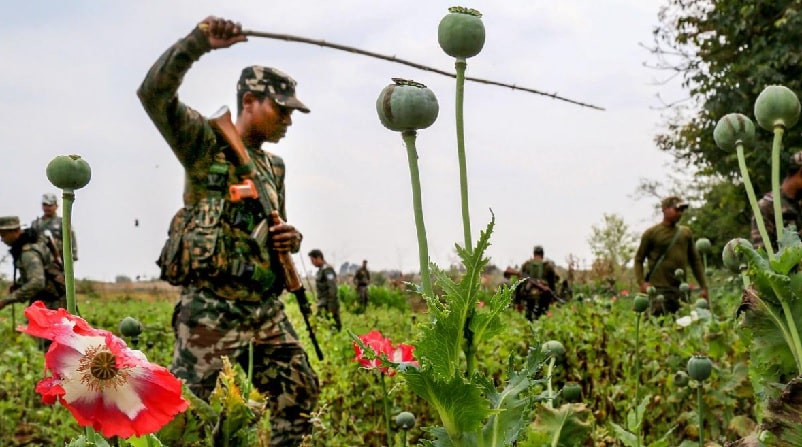What’s in today’s article?
- Why in news?
- Drug menace in India
- What are the Reasons for Widespread Drug Abuse in India?
- What are the Steps taken by the government to fight against drug menace in India?
- News Summary: Intensified Crackdown with aim to make India drug-free by 2047
- Intensified crackdown against drugs
Why in news?
- Aiming to make India drug-free by 2047, the Ministry of Home Affairs (MHA) plans to link recovery and usage of narcotics and banned substances in a particular area to the annual appraisal report of a District Superintendent of Police.
Drug menace in India
What are the Reasons for Widespread Drug Abuse in India?
- To escape from hard realities of life –
- The disintegration of the old joint family system, decline of old religious and moral values etc. lead to a rise in the number of drug addicts who take drugs to escape hard realities of life.
- Loosening of the traditional methods of social control
- The loosening of the traditional methods of social control left an individual vulnerable to the stresses and strains of modern life.
- Peers pressure
- Many youths start using drug under the pressure from their friends, seniors at educational institutions, or by members of their informal groupings.
- Easy Availability
- India is situated in the sense that on its west is the ‘Golden Crescent’ and on east is the ‘Golden Triangle’.
- Golden Crescent – Iran-Afghanistan-Pakistan
- Golden Triangle – Thailand, Laos, and Myanmar
- The usage of drugs in India is increasing, particularly in the border areas due to their porous nature.
- India is situated in the sense that on its west is the ‘Golden Crescent’ and on east is the ‘Golden Triangle’.
- Economic prosperity
- The agricultural reforms and other industrial activity have led to increase in income in regions like Punjab, Haryana, Maharashtra etc.
- Increase in disposable money and easy availability of drugs has led to increase in its use.
What are the Steps taken by the government to fight against drug menace in India?
- Article 47 of the Indian Constitution directs the State to endeavour to bring about prohibition of the consumption of intoxicating drugs injurious to health.
- India is a signatory to
- the single Convention on Narcotic Drugs 1961, as amended by the 1972 Protocol,
- the Conventions on Psychotropic Substances, 1971 and
- the United Nations Convention against Illicit Traffic in Narcotic Drugs and Psychotropic Substances, 1988.
- Legislative steps:
- Enacted Drugs and Cosmetics Act, 1940,
- Narcotic Drugs and Psychotropic Substances (NDPS) Act, 1985 and
- The Prevention of Illicit Traffic in Narcotic Drugs and Psychotropic Substances Act, 1988.
- Institutions involved
- The Narcotics Control Bureau was created in 1986 as a nodal agency to fight against this menace.
- Ministry of Health and Family Welfare (MoHFW) and Ministry of Social Justice and Empowerment (MSJE) are involved with alcohol and drug demand reduction policies and drug de-addiction programme.
News Summary: Intensified Crackdown with aim to make India drug-free by 2047
Intensified crackdown against drugs
- Opium and cannabis cultivation targeted
- Opium and cannabis cultivation in area the size of over 89,000 football fields has been destroyed in the past three years.
- According to the Narcotics Control Bureau (NCB), in the past three years, 35,592 acres of poppy cultivation and 82,691 acres of cannabis cultivation has been destroyed across the country.
- The States where the crops were destroyed are:
- Arunachal Pradesh, Assam, Manipur, Jharkhand, Madhya Pradesh, Himachal Pradesh, Jammu and Kashmir, Gujarat, Maharashtra, Odisha, Tripura, and Telangana.
- Fixing accountability
- MHA is planning to link recovery and usage of narcotics and banned substances in a particular area to the annual appraisal report of a District Superintendent of Police.
- This will bring accountability and fix responsibility.
- Use of technology
- The MHA has constituted a study group to analyse the use of drones in the destruction of illegal crops in remote areas.
- The NCB also shares satellite images with the affected States.
- On the National Narcotics Coordination portal (NCORD), the source and destination of drugs are highlighted too, and information up to the district levels is maintained.
- Another database, called NIDAAN, has the photographs, fingerprints, court orders, information and details of all suspects and convicts arrested under the Narcotic Drugs and Psychotropic Substances (NDPS) Act so far.
- This can be accessed by State and Central law enforcement agencies.
- Liberal application of the PITNDPS Act
- The Ministry is encouraging the liberal application of the Prevention of Illicit Traffic in Narcotic Drugs and Psychotropic Substances Act (PITNDPS), 1988.
- Earlier, this act was not being used much.
- This includes a provision to detain an individual for up to two years without a court’s intervention.
- The Ministry is encouraging the liberal application of the Prevention of Illicit Traffic in Narcotic Drugs and Psychotropic Substances Act (PITNDPS), 1988.
- Tackling the issue of dark net and crypto currency
- The use of the ‘dark net’ and crypto currency in illegal drugs is increasing, and in 2020, 2021 and 2022, NCB investigated 59 such cases.
- A sub-group on the counter-terrorism portal, the Multi Agency Centre (MAC), has been created to share inputs on the use of the dark net and crypto currency for trade in narcotics.
- Anti-Narcotics Task Forces (ANTF)
- All States have created dedicated Anti-Narcotics Task Forces (ANTF). The first ever conference of State ANTFs was held on April 19-20.
- Destruction of seized drugs through proper process
- Unless seized drugs were destroyed through proper process, there will be chances of rotation of drugs due to corruption.
- Recently, the Minister of Home Affairs said that the destruction should be held in public.
- So far, 6.7 lakh kilogrammes of drugs have been burnt by government agencies.
- Alternate livelihood scheme
- State governments have also launched alternate livelihood scheme for farmers growing poppy illegally.
- They also provide cash incentives to destroy the illegal crops.
Q1) What is golden triangle?
The Golden Triangle is a region in Southeast Asia that encompasses parts of Myanmar, Laos, and Thailand. It is one of the world’s largest producers of opium and heroin, with most of the opium produced in the region being refined into heroin and trafficked to other parts of the world. The Golden Triangle has been a major source of heroin for several decades, and drug trafficking from this region continues to be a significant problem.
Q2) What is Golden crescent?
The Golden Crescent, on the other hand, is a region in South Asia that includes parts of Afghanistan, Pakistan, and Iran. It is one of the world’s largest producers of opium, and Afghanistan is the largest producer of opium in the world. The opium produced in the Golden Crescent is also refined into heroin and trafficked to other parts of the world, particularly Europe and North America.
Source: Centre intensifies crackdown with aim to make India drug-free by 2047 | PIB| Narcotics India
Last updated on June, 2025
→ UPSC Notification 2025 was released on 22nd January 2025.
→ UPSC Prelims Result 2025 is out now for the CSE held on 25 May 2025.
→ UPSC Prelims Question Paper 2025 and Unofficial Prelims Answer Key 2025 are available now.
→ UPSC Calendar 2026 is released on 15th May, 2025.
→ The UPSC Vacancy 2025 were released 1129, out of which 979 were for UPSC CSE and remaining 150 are for UPSC IFoS.
→ UPSC Mains 2025 will be conducted on 22nd August 2025.
→ UPSC Prelims 2026 will be conducted on 24th May, 2026 & UPSC Mains 2026 will be conducted on 21st August 2026.
→ The UPSC Selection Process is of 3 stages-Prelims, Mains and Interview.
→ UPSC Result 2024 is released with latest UPSC Marksheet 2024. Check Now!
→ UPSC Toppers List 2024 is released now. Shakti Dubey is UPSC AIR 1 2024 Topper.
→ Also check Best IAS Coaching in Delhi






















